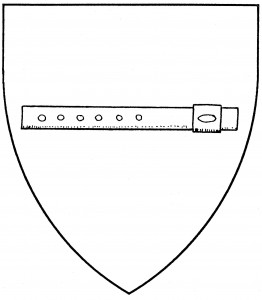A flute is a musical instrument consisting of a long slender tube with a mouth hole and six finger holes. It’s played by blowing transversely across the mouth hole; it is thus also blazoned a “transverse flute”.
This type of flute was popularized in 16th Century German texts, notably Agricola’s Musica instrumentalis deudsch, 1528, and is sometimes called a “German flute” for that reason; but the type was common throughout period Europe and Asia. The flute was mentioned as an heraldic charge by Guillim, 1610 [225], though unattributed.
There were other types of flutes which, instead of transverse blowing holes, had fipple mouthpieces (as did the recorder), but the unqualified term “flute” is a transverse flute by Society default. The flute is shown affronty by default, with the finger holes towards the viewer; it does not seem to have a default orientation. The illustration shows a flute fesswise.
Yrmegard Pfeyfferin bears: Azure, a flute fesswise argent.
Valia the Goth bears: Sable, three flutes palewise argent.
Rodolphus Amadeus Gilberti bears: Argent, a wooden flute bendwise proper garnished Or.
